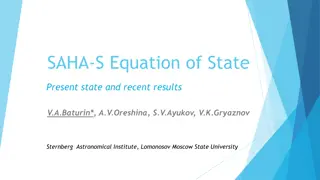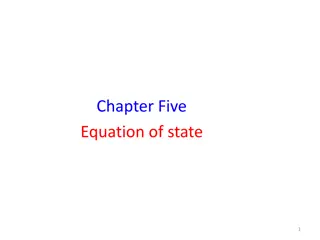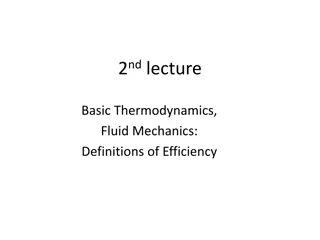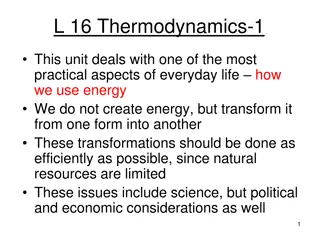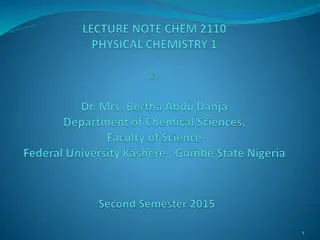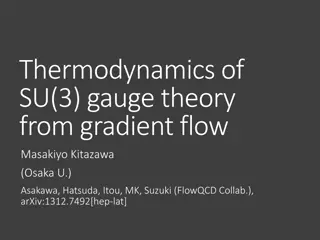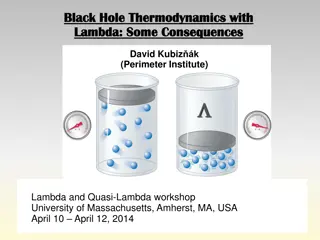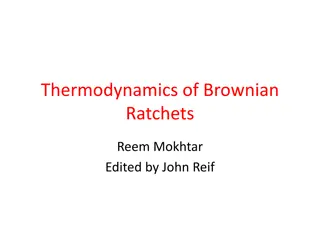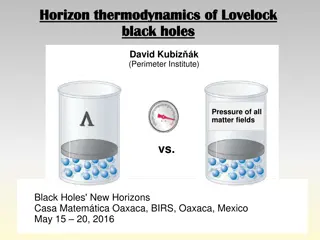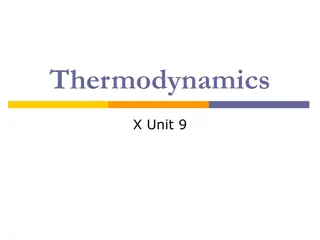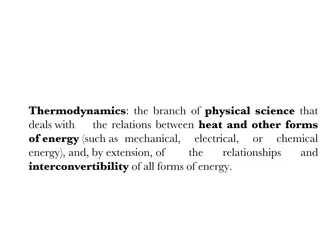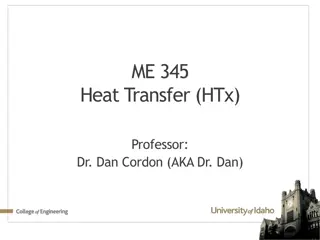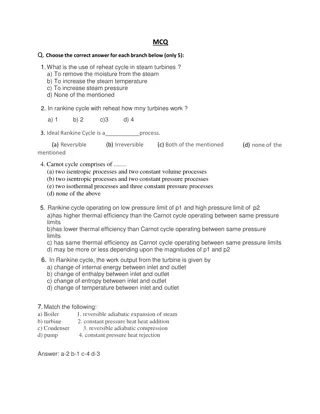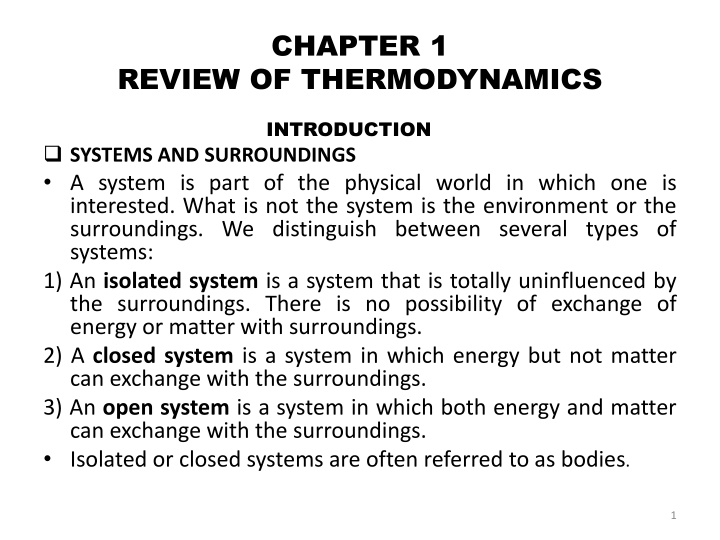
Introduction to Thermodynamics: Systems, Surroundings, and State Variables
Understanding thermodynamics involves the study of systems and their surroundings, classified as isolated, closed, or open. Thermodynamics explores concepts such as heat flow, energy, and entropy, while utilizing state variables to describe equilibrium states of a system. State variables like temperature, pressure, and energy play a crucial role in characterizing macroscopic thermodynamic properties.
Download Presentation

Please find below an Image/Link to download the presentation.
The content on the website is provided AS IS for your information and personal use only. It may not be sold, licensed, or shared on other websites without obtaining consent from the author. If you encounter any issues during the download, it is possible that the publisher has removed the file from their server.
You are allowed to download the files provided on this website for personal or commercial use, subject to the condition that they are used lawfully. All files are the property of their respective owners.
The content on the website is provided AS IS for your information and personal use only. It may not be sold, licensed, or shared on other websites without obtaining consent from the author.
E N D
Presentation Transcript
CHAPTER 1 REVIEW OF THERMODYNAMICS INTRODUCTION SYSTEMS AND SURROUNDINGS A system is part of the physical world in which one is interested. What is not the system is the environment or the surroundings. We distinguish between several types of systems: 1) An isolated system is a system that is totally uninfluenced by the surroundings. There is no possibility of exchange of energy or matter with surroundings. 2) A closed system is a system in which energy but not matter can exchange with the surroundings. 3) An open system is a system in which both energy and matter can exchange with the surroundings. Isolated or closed systems are often referred to as bodies. 1
THERMODYNAMICS The subject area "thermodynamics", comes from the Greek roots thermos, meaning "heat" and dynamis, meaning power. The study of temperature, energy, work, heating, entropy, and related macroscopic concepts comprise the field known as thermodynamics The study of interrelationships among macroscopic properties is called thermodynamics. Thermodynamics is concerned about heat and the direction of heat flow, whereas statistical mechanics gives a microscopic perspective of heat in terms of the structure of matter and provides a way of evaluating the thermal properties of matter, for e.g., heat capacity. 2
Cont Thermodynamics is a phenomenological theory of matter. As such, it draws its concepts directly from experiments The phenomenological approach, based on observation. A phenomenological theory is one in which initial observations lead to a law. The following is a list of some working concepts which the physicist, through experience, has found it convenient to introduce. (a ) A thermodynamic system is any macroscopic system. (b) Thermodynamic parameters are measurable macroscopic quantities associated with the system, such as the pressure P, the volume V, the temperature T, and the magnetic field H. They are defined experimentally. 3
Cont (c) A thermodynamic state is specified by a set of values of all the thermodynamic parameters necessary for the description of the system. (d) Thermodynamic equilibrium thermodynamic state of the system does not change with time. (e) Equilibrium state: properties of system are uniform throughout and do not change in time unless is acted up on by external influences. For example, a hot cup of coffee cools and takes on the temperature of its surroundings regardless of its initial temperature. The final states of such systems are called equilibrium states, which are characterized by their time independence, history independence, and relative simplicity prevails when the 4
State variable and equation of state A state variable: is any thermodynamic quantity that has a well-defined value in any particular state of the system. State variables are thermodynamic properties which describe equilibrium states. The state variables of equilibrium system are constant in time Thermodynamic properties are properties that do not depend on the rate which something happens. Some thermodynamic properties are: Temperature, Pressure, energy, amount of substance, etc. State variables are parameters characterizing the macroscopic thermodynamic state. These are all extensive or intensive: Extensive variable: change value when the size (spatial volume and the number of degrees of freedom) is changed: volume V , particle number N, internal energy U, entropy S, total magnetic moment 5
Cont For example, electric current and thermal conduction are rates and do not thermodynamic variables. The purpose of thermodynamics is to describe the properties of various macroscopic systems at or near equilibrium. This is done with the help of several state variables such as internal energy, volume, pressure, number of particles, temperature, entropy, chemical potential. For a complete description of a macroscopic body (system), it is not enough to specify the identity of the substance. The state of the system must also be specified. The state is completely defined by the values of thermodynamic properties or variables of the system. 6
Cont The state variable are fully determined by the values at the present and do not depend on the past history of the system In general not all variables need to be specified to define the state of the system because; the variables are interdependent and only a small number can be varied independently. These referred to as independent variables. The rest are dependent variables. 7
Cont For each system there are a certain number of the macroscopic variables (designated the independent variables) which must be given in order to be able to determine all of the other macroscopic variables (referred to as the dependent variables). Although the number is fixed for a given system, there are usually many choices for the particular set of independent variables. For example : simple fluid (homogeneous gas or liquid): 2 independent v P, V or T, P or U, V etc. gas of electric dipoles : 3 independent variables P, V, E or T, P,P etc. 8
Equations of state Relationships, expressing intensive parameters in terms of the independent extensive parameters, are called equations of state. The equation of state of thermodynamic system expresses the fact that not all of its state variables are independent. Consider a system described by two state variables X and Y, apart from the temperature T. For example, an ideal gas is describes by the values X= V(volume) and Y= P (pressure).suppose the system is initially in equilibrium at T. For the system to remain in equilibrium, a given variation of X must be accompanied by a specific variation in Y. If Y is not varied by this amount, the system goes out of equilibrium. There must , therefore exist an equation of state : f(X, Y, T) = 0, relating X, Y and T for all equilibrium configuration 9
Cont For example the equation of an ideal gas is f(V, P,T) = PV NKT = 0 For non-equilibrium states, f 0 Exercise For a certain ideal gas, the variables E, p, V,N, T are interrelated by the following equations: E = (3/2)NkT, pV = NkT, N = constant. What is ( E/ p)V 10
Laws of thermodynamics (a)Zeroth law of thermodynamics Zeroth Law states that if two bodies are in thermal equilibrium with a third, they are in thermal equilibrium with each other (b) First law of thermodynamics The First Law can be interpreted as a statement of conservation of energy. The first law of thermodynamics states that energy is conserved in any process involving a thermodynamic system and its surroundings. 11
Cont It is convenient to the change in internal energy dE equals to a combination of heat, dQ added to the system and work done by the system, dW. Taking dE as an infinitesimal change in internal energy, we can write dE = dQ dW For varying volume case (Isobaric = constant) dE = dQ PdV 12
Cont (c) Second law of thermodynamics It is an expression of the tendency that overtime differences in temperature, pressure, and chemical potential equilibrate in an isolated system. The law introduces the new property is called entropy. From the state of thermodynamics equilibrium, the law deduced the principle of the increase of entropy and explains the phenomenon of irreversibility in nature 13
Cont In statistical physics, an irreversible process corresponds to an increase of the number of accessible states for the considered system, and consequently to an increase of disorder and entropy The second law can be state as follows: a) In any process in which a thermally isolated system goes from one macrostate to another, the entropy tends to increase .i.e S 0 Hence, the entropy of an isolated system in equilibrium is constant and has its maximum value. 14
Cont b) If the system is not an isolated and undergoes an infinitesimal quasi-static process in which it absorbs heat dQ, then a change in internal energy of the system is the infinitesimal transfer of heat to a closed system driving a reversible process, divided by the equilibrium temperature of the system In symbol, dS = dQ/T 15
Cont The statements of the second law of thermodynamics are summarized as: No process is possible whose sole result is the complete conversion of energy transferred by heating in to work .(Kelvin statement) No process is possible whose sole result is cooling a colder body and heating a hotter body. (Clausius statement) This means that, heat energy does not spontaneously go from a colder to a hotter body (c) Third law of thermodynamics 16
Thermodynamic potentials Thermodynamic potentials are scalar quantities which used to represent the thermodynamic state of a system. For example: Internal energy Enthalpy Helmholtz free energy Gibbs free energy Landau potential or grand potential 17
Internal energy (E or U) For a reversible transformation, the first law of thermodynamics is given by: dU = TdS PdV + dN---------* This equation tells us the Internal energy U can be expressed as a function of S, V and N That is, U = U(S,V,N) Then purely mathematically, we have dU = ( U/ S)V,N dS + ( U/ V)S,N dV + ( U/ N)V,sdN ----------** 18
Cont It gives the formal definitions for T, P and T = ( U/ S)V,N ,P = - ( U/ V)s,N If U is known as a function of S, V and N, then the related quantities T, P and can be calculated The interpretation of U = U(S,V,N) is that S,V and N can be considered to be the independent state variables and that U is a dependent quantity, T, P and are also dependent state variables For fixed N, an equilibrium configuration (state) is fully specified by giving the values of S and V. Alternatively, U=U(S,V,N) could be inverted to give S = S(U,V,N) which make E is an independent variable and S is a dependent one. and = ( U/ N)V,s 19
Cont The point is that the four quantities U, S, V and N all are not independent state variables The function U(S,V,N) is called the first instance of a thermodynamic potential == a function that generates other thermodynamic variables (such as T, P, and ) by partial differentiation 20
Enthalpy (H) Enthalpy is the maximum amount of thermal energy derivable from a thermodynamic process in which the pressure is held constant Enthalpy is equivalent to total heat content of the system under constant pressure Also, enthalpy is the total amount of energy one needs to provide to the system and then place it in the atmosphere: H = U + PV This can be written as dH(S, P,N) = dU + d(VP), but dU = TdS PdV + dN , and d(VP) = pdV + Vdp dH(S, P,N) = TdS + VdP + dN , which states that : H = H(S,P,N) We also obtain formal definitions of T, V and : T = ( H/ S)p,N, V = ( H/ p)s,N and = ( H/ N)p,s 21
Helmholtz free energy(F) It is the amount of thermodynamic energy which can be converted into work at constant temperature and volume. In chemistry, this quantity is called work content. (or is it just the \measures the `useful' work obtainable" That is, it is a measure of useful work obtainable from a closed thermodynamic system at constant temperature and volume We define Helmholtz free energy as F = U TS, this implies that: dF = dU d(TS) dF = SdT- PdV + dN Which states that, F = F(T,V,N) We also obtain the formal definitions of S, P and : S = -( F/ T)V,N, P = -( F/ V)T,N and = ( F/ N)T,V 22
Gibbs free energy(G) Gibbs free energy is the amount of thermodynamic energy in a fluid system which can be converted into work at constant temperature and pressure. This is the most relevant state function for chemical reactions in open containers. Thus, Gibbs free energy is a measure of chemical energy We define the Gibbs free energy as G = U TS + PV = F + PV dG = dU d(TS) + d(PV) dG = - SdT + VdP + dN, which states that G = G(T,P,N) We also obtain formal definitions for S, V and T = ( G/ T)p,N, V = ( G/ p)T,N and = ( G/ N)p,T 23
Landau potential() It is also called grand potential We define the landau potential: = U TS N d = -SdT PdV Nd , Which states that, = (T,V, ) We also obtain formal definitions for S, P and N T = - ( / T)V,N, P = - ( / p)T,N N = - ( / )T,V and 24
MAXWELLS RELATIONS The formal definitions for T, S, V, P, and N in terms of the potentials E, H, F, G, and can be used to generate many relations between the various derivatives of these quantities . The equation dU = TdS PdV + dN, Implies that, T = ( U/ S)V,N ,P = - ( U/ V)s,N ?T/?V = ( 2U/ V S)V,N , Since the order of differentiation does not matter, we obtain ?T/?V = ( 2U/ S V)V,N = - ( P/ S)v,N In other words, (?T/?V)s,N=- ( P/ S)v,N This is the first instance of what is known as a Maxwell relations. Other relations follow just as easily from other thermodynamic potentials. (show!) (?T/?P)s,N=( V/ S)p,N, , (?S/?V)T, =( P/ T)v, and (?S/?P)T,N=- ( V/ T)P,N The Maxwell relations are extremely general; they hold for any thermodynamic system Exercise: Drive the Maxwell relations corresponding to : a) Enthalpy b) Helmholtz free energy c) Gibbs free energy d) Landau potential 25
The Gibbs-Duhem relation It is a relation ship among the intensive parameters of the system It follows that, for a simple system with l components , there will be l + 1 independent or degrees of freedom For example, a simple system with a single component will have two parameters such as pressure and volume The law is named after Josiah Willard Gibbs and Pierre Duhem. The Gibbs-Duhem relation is given by: = - SdT + VdP Activity: ? Nid i ?=1 Derive the Gibbs-Duhem equation from basic thermodynamic a state equation 26
Thermodynamic response functions Response functions are thermodynamic quantities most accessible to experiment. They give us information about how a specific state variable changes as other independent state variables are changed. They can be classified as: mechanical responses oisothermal and adiabatic compressibility, KT and KS, the isobaric expansion coefficient, p, and the pressure coefficient, thermal (heat capacity ) responses othe specific heats at constant pressure and constant volume i.e. Cp and Cv 27
Cont 28
Cont 29
Cont 30
Cont 31
Cont 32
Thermodynamic Equilibrium and Conditions for Equilibrium Thermodynamic Equilibrium A thermodynamic system is said to be in thermodynamic equilibrium, when it is in thermal equilibrium, mechanical equilibrium, irradiative equilibrium and chemical equilibrium. Thermodynamic equilibrium is characterized by the minimum of a thermodynamic potential such as: Helmholtz free energy Gibbs free energy The process that leads to a thermodynamic equilibrium is called thermalization. 33
Conditions for Equilibrium By considering the differential form of thermodynamic potentials, the following relationships can be derived. 1. For a completely isolated system, s = 0 at equilibrium 2. For a system at constant temperature and volume, A = 0 3. For a system at constant temperature and pressure, G = 0 The various types of equilibriums are achieved as follows 4. Two systems are in thermal equilibrium when their temperatures are the same 5. Two systems are in mechanical equilibrium when their pressures are the same 6. Two systems are in diffusive equilibrium when their chemical potentials are the same 34
Thermodynamics of Phase Transition A phase transition is the transformation of a thermodynamic system from one phase or state of mater to another During a phase transition of a given medium, certain properties of the medium will change The phase transition is most commonly used to describe transitions between solid, liquid, and gaseous states of matter in rare cases including plasma Activity 1. List types of phase transitions 2. Define the following a. Triple point b. Critical point 35
Cont 36
Cont 37
Cont 38
Cont 39
Cont Because of phase coexistence, phase diagrams are simplest in force - type coordinates (T, p, , H, . . .) 40
Exercise 1. Given the following expression for the entropy of a system: S = Nkln( VE3/2/N5/2) where is constant, obtain all the thermodynamic information about system, P, T, etc. 2. From the above , show that the chemical potential for a monatomic ideal gas is given by: = -kTln(bVT3/2/N), where b is a constant. 3. The free energy for a photon gas is given b F = - VT4 where, b is constant. Calculate: a) The entropy of the photon gas b) The Pressure of the photon gas and it equation of state c) The energy of the gas d) The chemical potential of the gas 3. Verify the Maxwell relations for: a) Ideal gas b) Photon gas 42


